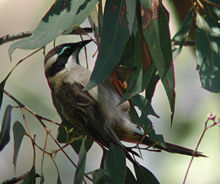- Black-chinned Honeyeater
-
Black-chinned Honeyeater 
In Queensland, Australia Conservation status Scientific classification Kingdom: Animalia Phylum: Chordata Class: Aves Order: Passeriformes Family: Meliphagidae Genus: Melithreptus Species: M. gularis Binomial name Melithreptus gularis
(Gould, 1837)Synonyms Melithreptus laetior (Gould, 1875)
The Black-chinned Honeyeater (Melithreptus gularis) is a species of passerine bird in the Meliphagidae family. It is endemic to Australia. Two subspecies are recognised. Its natural habitats are temperate forests and subtropical or tropical dry forests.
The Black-chinned Honeyeater was first described by John Gould in 1837. He also described what he called the Golden-backed Honeyeater of northern Australia in 1875, now considered a subspecies as there is a broad band of overlap with intermediate forms.
It is a member of the genus Melithreptus with several species, of similar size and (apart from the Brown-headed Honeyeater) black-headed appearance, in the honeyeater family Meliphagidae. Molecular markers show the Black-chinned Honeyeater is most closely related to the Brown-headed, while the similarly plumaged Strong-billed Honeyeater was actually an earlier offshoot between 6.7 and 3.4 million years ago.[2]
A mid-sized honeyeater ranging from 14 to 16 cm (5.6–6.4 in) in length, it is olive brown above and buff below, with a black head, nape and throat, with a bluish patch of bare skin over the eye and a white crescent-shaped patch on the nape. The legs and feet are orange. Juveniles have an all-over browner plumage. It makes a scratchy creep-creep-creep call, as well as a more musical one.[3]
The range is across northern Australia, from northwest Western Australia from the Kimberley, Pilbara, Great Sandy and northern Gibson Deserts, the Top End and the Gulf Country and Cape York of Queensland, through central and eastern Queensland and into central New South Wales. It occurs east of the Great Divide in the Northern Rivers region but is rare further south and appears to have declined in the Sydney region. It is found across central and northern Victoria and into eastern South Australia.[3] It is considered vulnerable in New South Wales,[4] and South Australia,[5] although is secure overall. It lives in open woodland and dry sclerophyll forest, often near watercourses.[3]
Insects form the bulk of the diet, and like its close relatives the Brown-headed and Strong-billed Honeyeaters, the Black-chinned Honeyeater forages by probing in bark of trunks and branches of trees.[2]
Black-chinned Honeyeaters may nest from July to December, breeding once or twice during this time. The nest is a thick-walled bowl of grasses and bits of bark lined with softer plant material hidden in the outer foliage of a tall tree, usually a eucalypt. One or (more commonly) two eggs are laid, 22 × 16 mm and shiny buff-pink sparsely spotted with red-brown (more on larger end).[6]
References
- ^ BirdLife International 2005. Melithreptus gularis. 2006 IUCN Red List of Threatened Species. Downloaded on 26 July 2007
- ^ a b Toon A, Hughes JM, Joseph L (2010). "Multilocus analysis of honeyeaters (Aves: Meliphagidae) highlights spatio-temporal heterogeneity in the influence of biogeographic barriers in the Australian monsoonal zone". Molecular Ecology 19 (14): 2980–94. doi:10.1111/j.1365-294X.2010.04730.x. PMID 20609078.
- ^ a b c "Black-chinned Honeyeater". Birds in Backyards. Birds Australia. 24 May 2006. http://birdsinbackyards.net/species/Melithreptus-gularis. Retrieved 23 July 2010.
- ^ "Black-chinned Honeyeater (eastern subspecies) - profile". Threatened species, populations & ecological communities in NSW. Department of Environment and Conservation, New South Wales Government. 1 September 2005. http://www.threatenedspecies.environment.nsw.gov.au/tsprofile/profile.aspx?id=10523. Retrieved 23 July 2010.
- ^ "Black-chinned Honeyeater - profile". Adelaide & Mount Lofty Ranges - Threatened species profile. Department for Environment and Heritage, South Australian Government. May 2008. http://www.environment.sa.gov.au/biodiversity/pdfs/regional_recovery/fauna/birds/black-chinned-honeyeater.pdf. Retrieved 23 July 2010.
- ^ Beruldsen, Gordon (2003). Australian Birds: Their Nests and Eggs. Kenmore Hills, Qld: self. pp. 314–315. ISBN 0-646-42798-9.
External links
Categories:- IUCN Red List least concern species
- Melithreptus
- Birds of South Australia
- Animals described in 1837
Wikimedia Foundation. 2010.

